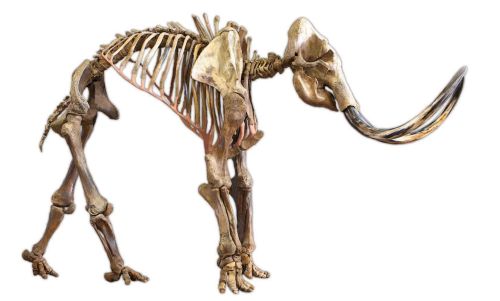Netherlands 2023 "Prehistoric animals (I)"
| <prev | back to index | next> |
| Issue Date | 13.06.2023 |
| ID | Michel: N/A, Scott: N/A, Stanley Gibbons: N/A, Yvert et Tellier: N/A, Category: pR |
| Design | stamps: studio026, Velp animal models: ManimalWorks, Rotterdam |
| Stamps in set | 15 |
| Values |
Mini-Sheet of 5 stamps:
1 - sabre-toothed cat, Homotherium latidens
- 3 stamps with reconstruction and 2 stamps with fossils of the animal. Mini-Sheet of 5 stamps: 1 - Woolly Mammoth, Mammuthus primigenius - 3 stamps with reconstruction and 2 stamps with fossils of the animal. Mini-Sheet of 5 stamps: 1 - Fin whale, Nehalaennia devossi - 3 stamps with reconstruction and 2 stamps with fossils of the primitive fin whale. Value indication 1 for mail up to and including 20g to a destination within the Netherlands. |
| Size (width x height) | stamps: 30mm x40mm Mini-Sheet: 170mm x 122mm |
| Layout | 3 Mini-Sheets of 5 stamps each |
| Products | None |
| Paper | normal with phosphorus pressure |
| Perforation | |
| Print Technique | Offset, 3 color: cyan, magenta, yellow and black |
| Printed by | |
| Quantity | 5,000 of each Mini-Sheet |
| Issuing Authority | PostNL |
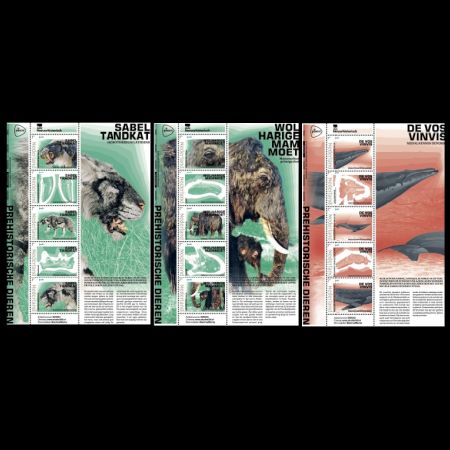
On June 13th, 2023, the Post Authority of the Netherlands, PostNL, issued the first 3 of 12 Mini-Sheets with personal stamps of "Prehistoric Animals".
Personal stamps are stamps proposed by some individuals or organizations, accepted, printed and sold by PostNL.
PostNL is going to issue 3 stamp sheets per quarter for the next three quarters. The denomination on these stamps is "1", the rate for items weighing up to 20g with destinations in the Netherlands and has a value of €1,01 at the time of issue.Each stamp sheet in the "Prehistoric Animals" series includes five personal stamps in five different designs. Three stamps feature various images of the prehistoric animal in its natural habitat. The other two stamps feature fossils of the same animal, surrounded by drawn earth layers in which that fossil was found.
|
|
The design of the stamps was created by studio026 in Velp.
Studio026 has two graphic designers, Anne Schaufeli and Huub de Lang. Both studied graphic design at ArtEZ University of the Arts in Arnhem from 2004 to 2008. Since 2009, the firm has focused on designs that are conceptually, editorially and aesthetically sound. The graphic designers believe in conceptual thinking and take space and time for research, experimentation and innovation.
Before starting their work on the stamps, Anne Schaufeli and Huub de Lang visited the Natural History Museum Rotterdam."This museum has a great collection of fossils, mostly from Dutch soil, Bram Langeveld, the curator, had inspiring stories to tell. He told us about prehistoric animals that we didn’t even know existed. The museum doesn’t have any visual material in its collection. We didn’t just want to show bones – we also wanted to depict the animal itself. That’s why we started looking further afield. " Schaufeli said.
The Natural History Museum Rotterdam has its origins in collecting animals, shells, fossils and other naturalia from the Cabinet of Dr A. B. van Deinse. The museum was founded in 1927. Since 1987, it has been based in Villa Dijkzigt on Westzeedijk in Museumpark [an urban park in Rotterdam]. The Natural History Museum Rotterdam has a special place in the Rotterdam cultural sector and plays a pioneering role among Dutch natural history museums across the region. The museum attracts over 40,000 visitors each year.
After some meandering, their search led to Remie Bakker, a paleo-artist, in Rotterdam. His company, ManimalWorks produces models of prehistoric animals based on scientific data and information from cave drawings, for example.
Remie Bakker is a professional sculptor and has been working for several decades
with paleontologists,
each an expert in their field.
Based on scientific research, Remie Bakker brings together accurate data with the
profession of a sculptor.
This has resulted in a lifelike reconstruction of the woolly mammoth, the icon of
the ice age, and its contemporary, the woolly rhinoceros.
This is based on skeletal remains fished up from the bottom of the North Sea
between the British Isles and the continent of Europe, but also mummified carcasses
from the ever-frozen ground of Siberia and North America.
Due to the close cooperation of paleontologists and paleo-artists, very reliable
models have been created in this way.
Most of the reconstructions of prehistoric animals created by Remie Bakker were done under
supervision of a Dutch paleontologist Dick Mol.
Dick Mol, also known as "Sir Mammoth", born in 1955, is a specialist in the field of mammoths
and associated fauna for almost five decades.
He is a research associate of several museums.
Mol's primary focus is on mammals of the Quaternary period, including mammoths and extinct rhinoceros species.
Remie builds life-size reconstructions for educational purposes such as museums and scientific exhibitions. It’s just amazing how life-like his animal models look. They’re so life-like that you could just encounter them somewhere. Before the models go to the client, they are photographed in an environment that is as close as possible to their original habitat. These photos were used on the stamp sheets. We worked with drawings for the whales and the blunt-snouted dolphin. Some of them come from ManimalWorks. The models and drawings were combined with fossils from the Natural History Museum Rotterdam. From those combinations, we selected 12 prehistoric animals, all of which lived on Dutch soil at one stage.
We wanted to show not just the animal and the fossil, but the connection between them as well. While a beautiful image, the animal on its own doesn’t tell the full story. Our narrative is that by looking into the earth, you travel back in time. Shifts in the earth's strata bring fossils to the surface, and those fossils enable us to reconstruct prehistoric animals. We also compared the fossils with related species that are still around today.
First, all the images were detached and we made the colour photos of the fossils monochrome using the selected colour palette. Each geological epoch was given its own colour: a bright colour that matched the animals and their habitats. On the fossil stamps, you’re literally looking down into the earth.
This layering is echoed in the animal photographs, combined with the natural environment in which the animals existed. In all cases, the layers follow the contours of the image. Therefore, each stamp sheet has a different graphic translation.
The fossils were positioned as large as possible on the stamps. For the animals themselves, various cut-outs were selected in order to achieve as much variety as possible.
This also allowed us to zoom in on distinctive details. For example, we focused on the blue stripe on the Nothosaurus’ back, the woolly rhino’s large horn and the sabre-toothed cat’s huge fangs. They’re impressive beasts that you wouldn't want to encounter in real life. Sometimes, the images give you the wrong impression. When I saw the image of the large baleen whales for the first time, I thought they were fighting. But the drawing actually shows how they gather their food, by roughly rooting around the seabed.
Sabre-toothed cat, Homotherium latidens

Homotherium is an extinct genus of sabre-toothed cats that inhabited North America, South America, Eurasia, and Africa during the Pliocene and Pleistocene epochs from around 4 million to 12,000 years ago.
There is currently only one recognised species Homotherium in Eurasia during the Late Pliocene-Pleistocene, Homotherium latidens. In 1886, James Backhouse described the first Homotherium mandible found in the UK. It was a complete right mandible found in the Forest-bed Formation of Kessingland in Suffolk, dated to the early middle Pleistocene (780,000 to 450,000 years ago).
Homotherium first appeared during the Early Pliocene, with its oldest remains being from the Odesa catacombs in Ukraine, and Koobi Fora in Kenya, which are close in age, making the origin location of the genus uncertain.
Homotherium reached 1.1 meter at the shoulder and weighed an estimated 190 kg and was therefore about the size of a male lion.

|
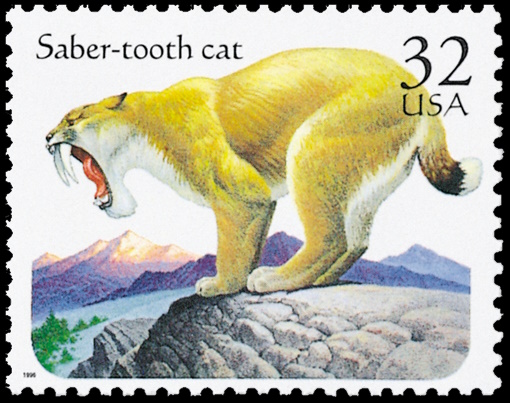
|
| Smilodon on stamp of USA 1996, MiNr.: 2738, Scott: 3080. |
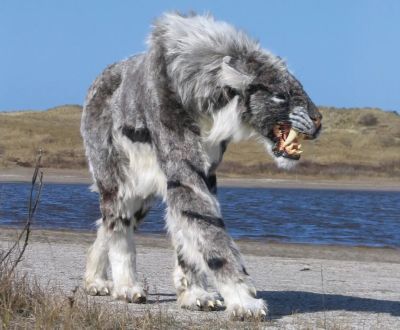 |
| Homotherium life-size model created by the Dutch sculptor Remie Bakker in 2006. Image credit Depositsmag. |
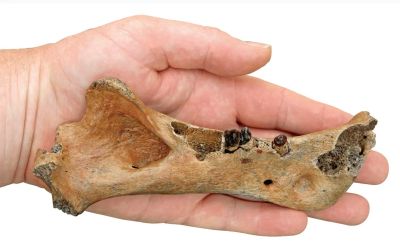 |
| Homotherium skull fished out by the trawler UK33 in 2000. Image credit Depositsmag. |
The large upper canines of Homotherium were likely hidden by the upper lips and gum tissues of the lower lips jaw similar to extant cats, unlike the larger upper canines of Smilodon. In comparison to Smilodon, the canines of Homotherium were shorter, and it was probably adapted to running down rather than ambushing prey.
This hypothesis is supported by comparable space between the canines and mandible at full closure of the jaws to modern cats; while Smilodon has significantly more space in this respect, likely for soft tissue to fit between the canine and mandible.
Homotherium was likely a social predator that would have specialized in hunting young mammoths and that subsequently dragged the kills into secluded caves to eat in relative peace.
The North Sea is being fished intensively today and Dutch fishermen not only collect flatfish
like sole and plaice, living on the sea floor.
They also retrieve the weirdest objects – fragments of shipwrecks from days gone by or bombs
from World War II, jettisoned by the bombers in the dark days of the previous century.
But the most intriguing discoveries are fossil remains from animals that lived here, in the
not-so-distant past, in a period when the world looked very different from today and when
animals grazed on what is now the bottom of the North Sea.
Fishermen have been finding fossils in their networks since at least 1874.
Urk is a municipality and a town in the Flevoland province in the central Netherlands.
The mainstay of the town's formal economy has always been fishing, and the products of
the sea coming in through Urk harbor continue to be exported widely,
although today Urk's fishing boats must travel greater distances to gather them than was
required in most historical periods.
The find is special because it was widely believed that the sabre-toothed cat went extinct in Western Europe 300,000 to 400,000 years ago. However, after research of the Urk's fossil, a team of specialists its age was estimated, based on radiocarbon dating, to be 28,000 years old. It was the first time that such a "young" fossil of a sabre-toothed cat has been discovered in Europe.
The North Sea mandible has inspired Remie Bakker.
In a couple of months, after consulting experts in the field of extinct and extant cats and Pleistocene vertebrates, he successfully brought the 28.000 years old Homotherium back to life.
On his website Mr. Bakker explains the reconstruction process:
When I started with the skull cast, I realized that the skull had to be reconstructed because the original skull had been deformed by the matrix. The colours is inspired by cold weather hunters like the snow panther (Panthera unica), lynx (Felis lynx) and the wolf (Canis lupus).
Woolly Mammoth, Mammuthus primigenius

The woolly Mammoth, is one of the most recognizable prehistoric animals, it is an extinct species of the mammoths of the elephant family who lived between 300 thousand and 200 thousand years ago, a tiny population of mammoths persisted on Wrangel Island, an Arctic island located off the coast of northern Russia, as late as 4,300 years ago.
"Mammoth, (genus Mammuthus), any member of an extinct group of elephants found as fossils in Pleistocene deposits (2.6 million years ago - 11,700 years ago), over every continent except Australia and South America and in early Holocene deposits of North America. The woolly, Northern, or Siberian mammoth (Mammuthus primigenius) is by far the best-known of all mammoths. " ENCYCLOPADIA BRITANNICA
The word mammoth was first used in Europe during the early 17th century, when referring to maimanto tusks discovered in Siberia. Fossil mammoth ivory was so abundant in that time, that it was exported from Siberia to China and Europe.For more details about woolly mammoth discovery, please click here.

|
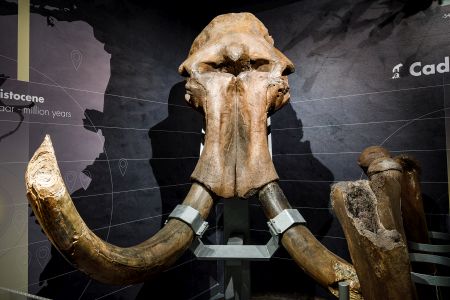 |
| Woolly mammoth skull sucked up by a sand dredger in the floodplains of the Meuse (Gewande, North Brabant). Image credit the Natural History Museum Rotterdam. |
It appears that the area between the UK and Holland, in the Pleistocene era, was not the North Sea we know today. Rather, it was a huge, mostly treeless, dry steppe, where the Thames from the West and the Rhine, Meuse and Schelde from the East meandered into river deltas before entering the Atlantic Ocean way to the North. This was the typical landscape at that time, the megafauna steppe, found stretching across the land masses of the Northern Hemisphere in which the mammoths, rhinos, steppe bison and their associated, large predators were thriving.
The enormous number of mammoths remains recovered from the North Sea suggests that large herds of these pachyderms roamed the area. In terms of a broader time frame, consider hundreds of thousands of animals on the North Sea mammoth steppe.
The most abundant remains are molars, due to their hardness and durability. The abundance of the last molars, also reveals that animals were reaching advanced ages, suggesting good health, which in turn suggests the presence of favorable environmental conditions. Unfortunately, to the stamp issue date, complete mammoth skeletons have never been found in the North Sea.
Sometimes, matching fossils are found in the nets of the fishermen. For instance, the upper and lower jaw of the same individual may be found together. This indicates that the animal must have lived and died in that area instead of being transported there over a great distance from the mainland to the sea by rivers or ice sheets.
In June 2005, Skipper Pieter Oost from Stellendam was fishing in the Eurogeul with his beam trawler "Zeearend", just within the 12-mile zone of the Netherlands. The fishermen were surprised to see a very large and unusual shape when they hoisted their net onto the deck. It was a large and complete mammoth skull with only the tusks being broken. A complete mammoth skull is not a common specimen from the North Sea and this one was among the biggest ever found in The Netherlands.
In 2013, the team of Mr. Dick Mol constructed a skeleton of a large male individual for the Hellevoetsluis Historyland Museum, the Netherlands. The skeleton was made up of 184 skeletal parts from many male individuals, all roughly of the same size. It is 513cm long and 330cm tall at the highest vertebra with the maximum width of 142cm at the pelvis. Except for the tusks, all bones are actual fossils, not a cast.
In 2020, the team constructed another woolly mammoth skeleton for the Naturkunde Museum of Dortmund, Germany.
|
"Mammuts - Stars der Eiszeit" is a documentary film made by ZDF broadcast company (Germany).
The narration is in German.
The film shows fossil "fishing" in the Netherlands, moderated by Dick Mol.
|
"Mammoths - Giants of the Ice Age" is an English, slightly different and shorter,
version of the ZDF's film.
The narration and subtitles are in English. You might need to set a VPN to the USA region to be able to watch it. Otherwise, you will see "Video unavailable" message even on the preview below. |
|
"Woolly mammoths of the Siberian Tundra" - lecture of "Sir Mammoth" (Dick Mol), on the right.
The voice is in English. The first third of the film is about Yukagir Mammoth, discovered in the Siberian Tundra and reconstruction created by Mr. Remie Bakker for EXPO'2005 show in Japan. There are several philatelic items related to the event: stamps of Japan, illustrated cover of Russia, etc. The second third is about mammoth fossils "fished" out the North Sea. In the last third, Dick Mol answers some questions from the audience. For more convenient viewing, use the full screen option. |
During a special fishing expedition, organised by Dick Mol, on April 22nd 2011 in search of Pleistocene mammal fossils, a fragment skull of woolly mammoth calf was dredged up. Research has shown that these remains belonged to a calf that was only one and a half years old at the time of death. These matching skeletal elements suggest that the mammoth remains were not transported very far from the discovery site.
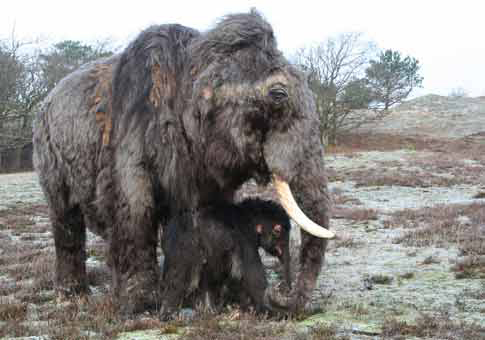 |
| The Mammoth female and calf reconstruction created by Dutch sculptor Remie Bakker in 2015. The reconstruction shown on the background of the Mini-Sheet with Mammoth stamps. Image credit: ManimalWorks. |
These reconstruction, was part of "The Ice Age" exhibition that travelled around Europe and later on, was purchased by REM Museum in Mannheim, Germany.
On his website Mr. Bakker explain the reconstruction process:
To get a better idea for the hair coat of this animal I used cave paintings as an example.
I feel that the people that made these paintings were seeing these animals in their daily
life and have used these images in the caves.
This is as true image as we can get from these animals.
Recent research has shown that the haemoglobin compounds in the blood of mammoths are better
is releasing of oxygen under lower temperatures than the blood of modern day elephants.
This will make the mammoths more vulnerable for overheating than under cooling.
If you look at cave paintings it seems that some paintings show inlets on the flanks and
armpits of the hair in mammoths.
The paintings seem to show a different streak of hair or an emphasis on the hair in this region.
This was the basis for the idea that the flanks and the armpits were balder than the body
to lose body heat.
If the animal stands with the legs from the body it cools and when it wants to stay warm
it stands with the legs closer to the body.
This will give the animal more control over his body heat.
Fin whale, Nehalaennia devossi

Most fossils fished out from the seabed of the North Sea are fossils of terrestrial prehistoric mammals from Pleistocene and Holocene epochs, however some marine mammal fauna is also known from the southwestern Netherlands, from the Miocene epoch, dating back approximately 8 million years.

|
One of the most spectacular discoveries of marine mammals is a primitive fin whale from the Western Scheldt, was made in 2014. It was named the "De Vos fin whale".
The Western Scheldt (Dutch: Westerschelde) in the province of Zeeland in the southwestern Netherlands, is the estuary of the Scheldt river. This river once had several estuaries, but the others are now disconnected from the Scheldt, leaving the Westerschelde as its only direct route to the sea. The Western Scheldt is an important shipping route to the Port of Antwerp, Belgium.
The Miocene and Pliocene outcrops in the southern portion of the North Sea (Belgium, Denmark and the Netherlands) are rich in fossil whales.During 2014, the trawler ZZ10 from Urk in collaboration with the Natural History Museum Rotterdam fished the remains of extinct whales, sharks and sea turtles from the bottom of the Western Scheldt in three targeted fishing trips.
The fossils are of exceptional quality and unique for Europe. Research makes it clear that these are large animals that are new to science.
In 2019, the fossil was described and named - Nehalaennia devossi. The genus name is after the name of the Keltic pagan goddess (Nehalaennia) of the sea which was also accepted by Romans when they conquered what is now the most southern province of the Netherlands.
The species name (devossi) is in honor Dr. John de Vos for his lifelong contribution to Dutch paleontology and his leading role in creating the unique bond and trust between Dutch professional and amateur paleontologists.
Nehalaennia devossi belongs to fin whales family Balaenopteridae and shows a surprisingly high number of advanced characters in the skull morphology. In particular, the skull shares morphological characters with the living humpback whale - Megaptera novaeangliae.
The fin whale (Balaenopteridae family), also known as finback whale
or common rorqual and formerly known as herring whale or razorback whale,
is a cetacean belonging to the parvorder of baleen whales.
It is the second-longest species of cetacean on Earth after the blue whale.
The humpback whale is a species of baleen whale.
It is a rorqual and is the only species in the genus Megaptera.
Adults range in length from 14–17 meters and weigh up to 40 metric tons.
The humpback has a distinctive body shape, with long pectoral fins and
tubercles on its head.
It is known for breaching and other distinctive surface behaviours, making it
popular with whale watchers.
Males produce a complex song typically lasting 4 to 33 minutes.
An important part of fin whale evolution to have taken place earlier then thought. Further study unraveled a pattern in the evolution of the fin whale family: during cold periods more species emerged and died during warm periods them right out. Researchers write this phenomenon to a larger one food availability during cold periods.
According to explanations of Mr. Remie Bakker,
he created the model of Nehalaennia devossi based on the holotype skeleton,
in cooperation with Mr. Klaas Post from the Natural History Museum Rotterdam,
who discovered and described the species.
A scale model was made, first, to understand the shape.
The basis was a wood frame model covered with polystyrene.
This was shaped with a chainsaw, wirebrush and sanding machines.
After the shape was done, Mr. Bakker covered the model with epoxy and sanded it smooth.
Eyes and details were placed and the model was painted.
The life-size model is on display in the museum "Historyland" in Hellevoetsluis.
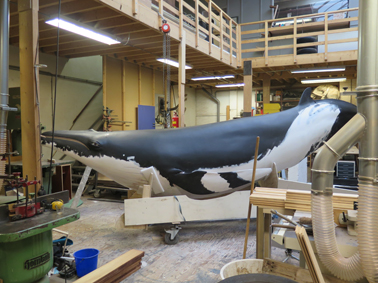 |
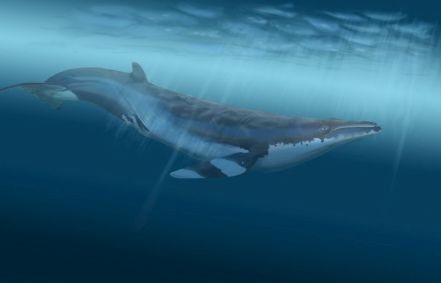 |
| Nehalaennia devossi whale reconstruction and drawing created by Dutch sculptor Remie Bakker. The images were provided by Mr. Remie Bakker. The drawing was reproduced by studio26 on the stamp. |
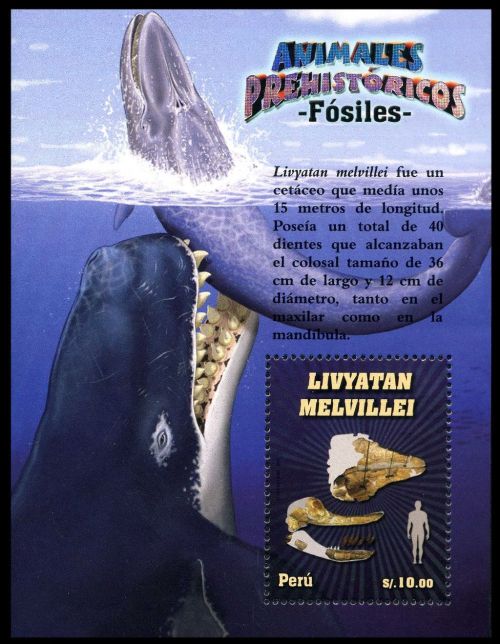 |
| The stamp of Peru 2011, MiNr.: 2599, Scott: 1799, shows Livyatan melvillei hunting a whale. |
Nehalaennia was a baleen whale that fed on a variety of small critters filtered out of the water, just as the blue whale still does today. The "De Vos whale" could swim reasonably fast, as indicated by the streamlining of its body. The whale lived in a not too deep, moderately cold sea, which contained a lot of food.
At the bottom of the head are the throat grooves that are so typical of fin whales. The fin whale can therefore take a huge mouthful of water (the throat expands) and then squeezes that water out through the baleen. The food remains behind and is licked off with the tongue.
The huge fin is actually an arm, just like a human, only the elbow cannot be moved and all the fingers have fused into one.
The vertebral arch of a whale, just like in humans, consists of cervical, thoracic, lumbar and caudal vertebrae. The number of cervical vertebrae (seven) is even equal to ours, but a whale has more thoracic vertebrae (about fifteen) and lumbar vertebrae (fifteen). The biggest difference is in the caudal vertebrae, which we hardly have (anymore), while a whale has around 27. The last lumbar vertebrae and the first caudal vertebrae are the largest and strongest vertebrae in the skeleton. A whale swims with its tail and not its fins. And to keep such a huge body moving, the lumbar and caudal vertebrae are subjected to daily stresses.
In that primeval ocean of that time a gigantic predatory sperm whale swam around. This sperm whale, who were the kings of the Miocene sea, probably also hunted the "De Vos fin whale".
The biggest of them was Livyatan melvillei.
The genus name was inspired by the biblical sea monster Leviathan, and the species name by Herman Melville, the author of the famous novel Moby-Dick about a white bull sperm whale.
It is mainly known from the Pisco Formation of Peru.
In November 2008, fossil remains of Livyatan melvillei were discovered in the sediments
of Pisco formation at Cerro Colorado, 35 kilometres south-southwest of Ica, Peru.
The remains include a partially preserved skull with teeth and mandible of a "sea monster"
three times the size of a modern-day killer whale.
The teeth were so large it was initially assumed they were elephant tusks.
For more details, please click here,
If Livyatan melvillei was alive today, it could easily bite through a modern passenger car, unlike a Tyrannosaurus rex.
Many species of sperm whales swam in the primeval sea, from small to large, and all with batteries of sharp teeth.
Each species hunted different prey such as fish, gulls and seals. The largest and strongest of them, as up to eighteen meters long Livyatan, who was very similar to today's sperm whale, probably hunted large baleen whales.
The difference is, in addition to the very muscular body, the large mouth with sharp teeth in both jaws (the recent sperm whale only has relatively small teeth in the lower jaw, which are a maximum of 20 cm long). The recent sperm whale is the last of the family still alive today.
About five million years ago, the once mighty sperm whales, including Livyatan, became extinct. Its extinction was probably also caused by a cooling event at the end of the Miocene period causing a reduction in food populations. The whale may have interacted with the large extinct sharks and dolphins, competing with them for a similar food source.
Products and associated philatelic items
| Examples of Circulated Covers | ||
| Some Covers posted from the Netherlands to Germany | ||
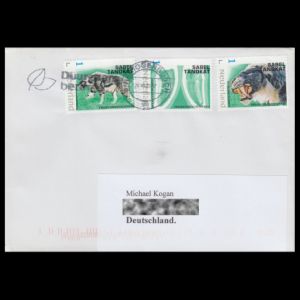 |
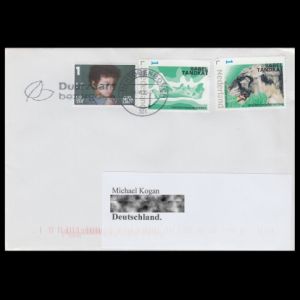 |
|
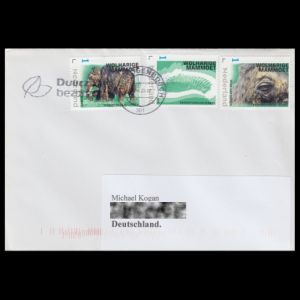 |
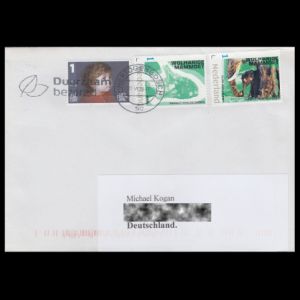 |
|
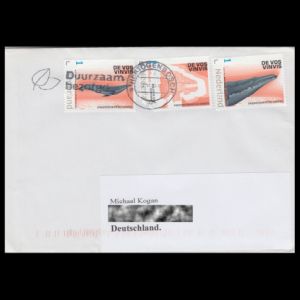 |
 |
|
| Some Covers posted from Rotterdam | ||
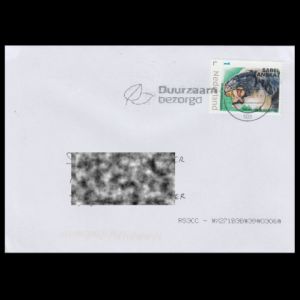 |
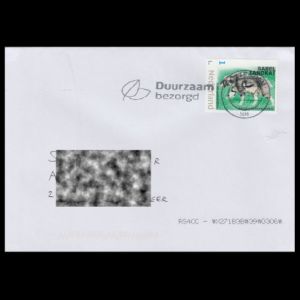 |
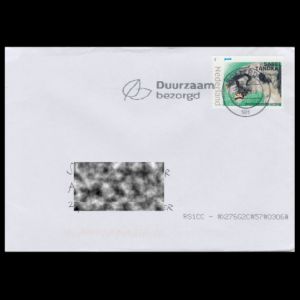 |
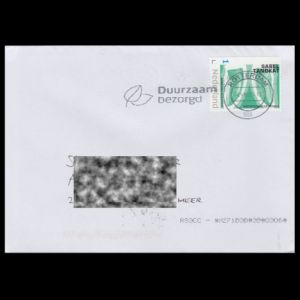 |
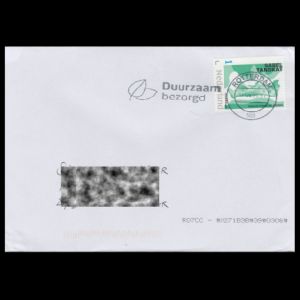 |
|
References
- Technical details: PostNL: [1], [2], [3]; WOPAplus.
- Design agency studion26: official website.
- Manimal Works agency of Remie Bakker: official website,
- Dick Mol: Wikipedia,
- The Natural History Museum Rotterdam: official website, Wikipedia.
- Urk: Wikipedia,
- Homotherium:
Wikipedia.
Depositsmag,
the Natural History Museum Rotterdam.
"Sabertooth" by Mauricio Anton, published by Indiana University press in 2013. ISBN: 978-0-253-01042-1.
- The reconstruction: ManimalWorks
- Wolly Mammoth, Mammuthus primigenius:
Wikipedia.
hetnatuurhistorisch.nl,
Depositsmag,
"Mammoth Fossils Recovered from the Seabed Between the British Isles and the European Continent", by Dick Mol, published in Bull. Mus. Anthropol. préhist. Monaco, suppl. n° 6, 2016.- The reconstruction: ManimalWorks
- Nehalaennia devossi:
Geology Association Friesland,
Novataxa,
Carnivora,
Het Natural History Museum:
[1],
[2],
"A new balaenopterid whale from the late Miocene of the Southern North Sea Basin and the evolution of balaenopterid diversity (Cetacea, Mysticeti)", by Bisconti M, Munsterman DK, Post K. 2019.- Livyatan: Wikipedia. Livyatan on postage stamp of Peru.
- Fin whale: Wikipedia.
Acknowledgements

|
- Many thanks to Dr. Peter Voice from Department of Geological and Environmental Sciences, Western Michigan University, for the draft page review and his very valuable comments.
- Many thanks to Mr. Dick Mol, a Dutch paleontologist for his help finding information about the animals depicted on these stamps, for the draft page review and his very valuable comments.
- Many thanks to Mr. Remie Bakker, for his permission to use images of his models, for sharing some images which were not published on his website at the time the article was written and for a very nice and productive email exchange.
- Many thanks to fellow collector Dr. Jos van den Bosch, from the Netherlands, for his help finding information about these stamps.
| <prev | back to index | next> |
